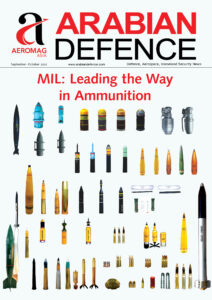 The Department of Defence Production envisions expanding the defence manufacturing base of the country with equal participation of both Public and Private sector including MSMEs and startups. To achieve this goal, broadly three focus areas have been identified: Investment promotion, export promotion and innovation, says Raj Kumar, secretary, Department of Defence Production, Ministry of Defence, Government of India. Excerpts from the interview:
The Department of Defence Production envisions expanding the defence manufacturing base of the country with equal participation of both Public and Private sector including MSMEs and startups. To achieve this goal, broadly three focus areas have been identified: Investment promotion, export promotion and innovation, says Raj Kumar, secretary, Department of Defence Production, Ministry of Defence, Government of India. Excerpts from the interview:
Export Promotion cell under DDP, MoD has been formed to co-ordinate and follow-up on export related action including enquiries received from various countries and facilitate private sector and public sector companies for export promotion.
What are the latest activities and policy initiatives by the Government to promote indigenous defence manufacturer in India?
The size of the Indian Defence Industry, including Aerospace and Naval Shipbuilding Industry, is currently estimated to be about Rs 80,000 Crore (2019-20). The Government targets a turnover of Rs 1,75,000 Cr (US$ 25Bn) in Aerospace and Defence goods and services by 2025, for which a number of policy initiatives have been taken:
Defence Procurement Procedure 2016 has been revised as Defence Acquisition Procedure (DAP) – 2020, which is driven by the tenets of Defence Reforms announced as part of ‘Aatmanirbhar Bharat Abhiyan’.
In order to promote indigenous design and development of defence equipment ‘Buy Indian – IDDM (Indigenously Designed, Developed and Manufactured)’ category was introduced in 2016 and was accorded top most priority for procurement of capital equipment.
Ministry of Defence has notified a ‘Negative list’ of 101 items for which there would be an embargo on the import beyond the timeline indicated against them. This is a big step towards self-reliance in defence. This would offer a great opportunity to the Indian defence industry to manufacture these items using their own design and development capabilities to meet the requirements of the Armed Forces in the coming years. This list includes some high technology weapon systems like artillery guns, assault rifles, corvettes, sonar systems, transport aircrafts, light combat helicopters (LCHs), radars and many other items to fulfil the needs of our Defence Services.
“Offset portal” has been created in May 2019 to ensure Greater transparency, efficiency and accountability in the process. Reforms in Offset policy have been included in DAP 2020, with thrust on attracting investment and Technology for Defence manufacturing.
Government has notified the ‘Strategic Partnership (SP)’ Model in May 2017, which envisages establishment of long-term strategic partnerships with Indian entities through a transparent and competitive process, wherein they would tie up with global Original Equipment Manufacturers (OEMs) to seek technology transfers to set up domestic manufacturing infrastructure and supply chains.
Department of Defence Production has notified 46 items under the latest Public Procurement Order 2017 notified by Department for Promotion of Industry and Internal Trade (DPIIT), for which there is sufficient local capacity and competition and procurement of these items shall be done from local suppliers only irrespective of the purchase value.
Government has notified a ‘Policy for indigenisation of components and spares used in Defence Platforms’ in March 2019 with the objective to create an industry ecosystem which is able to indigenize the imported components (including alloys and special materials) and sub-assemblies for defence equipment and platform manufactured in India.
An Inter-Governmental Agreement (IGA) on “Mutual Cooperation in Joint Manufacturing of Spares, Components, Aggregates and other material related to Russian/Soviet Origin Arms and Defence Equipment” was signed in September 2019. The objective of the IGA is to enhance the After Sales Support and operational availability of Russian origin equipment currently in service in Indian Armed Forces by organizing production of spares and components in the territory of India by Indian Industry by way of creation of Joint Ventures/Partnership with Russian Original Equipment Manufacturers (OEMs) under the framework of the “Make in India” initiative.
The Government eagerly looks forward to boost defence exports. How strong is India’s defence export business and what are major export promotion policies taken?
The Government targets defence export of Rs 35,000 Cr (US$ 5 Bn) by 2025 from about Rs. 9,100 Cr in 2019-20, for which a number of export promotion initiatives have been taken:
Export Promotion cell under DDP, MoD has been formed to co-ordinate and follow-up on export related action including enquiries received from various countries and facilitate private sector and public sector companies for export promotion.
A High Level Committee (HLC) has been constituted under the Chairmanship of Raksha Mantri to facilitate faster clearances to export of major indigenous defence platforms to Friendly Foreign Countries.
A scheme for Export promotion of Indian Defence Equipment Manufactured in India by Indian Defence Attache has been rolled out wherein Defence Attachés are provided financial support to promote export of indigenous defence equipment abroad.
Webinars and expo are being organized with 25 countries with stakeholders/decision makers/Defence industries for export promotion of Indian Defence equipment. Out of 25 countries, webinar with 9 countries, including UAE have been organized.
An online system has been created by which Export leads received from various sources can be sent directly to Indian defence exporters registered on the defenceexim portal on their email address. This facility helps the Indian defence exporters to quickly respond to export opportunities arising in other countries.
DPSUs/OFB have been allocated geographical regions/countries to take up focused promotional activities.
Standard Operating Procedure (SOP) for the export of munitions list items have been simplified to promote Ease of Doing Business.
The existing online application system of export authorisation has been made more user-friendly to provide end to end solution.
The Department of Defence Production has brought in two OGEL’s (Open General Export License) – one for the select parts and components, and the other for intra-company transfer of technology. OGEL is a one-time export license, which permits the industry to export specified items to specified destinations, enumerated in the OGEL, without seeking export authorisation during the validity of the OGEL.
How does the Department plan to tap the potential of private industry in defence sector to support indigenization?
The private sector has received focused attention during the last six years by way of policy initiatives and interventions by the Government to promote their participation in defence, as mentioned below:
A number of provisions have been added or amended in DAP 2020 to provide level-playing field for Indian Private Industry.
Notification of ‘Negative list’ of 101 items would offer a great opportunity to the Indian defence industry, including private sector, to manufacture these items using their own design and development capabilities.
The ‘Make’ Procedure of capital procurement has been simplified. There is a provision for funding of 90% of development cost by the Government to Indian industry under Make-I category. In addition, there are specific reservations for MSMEs under the ‘Make’ procedure.
Separate procedure for ‘Make-II’ category (Industry funded) has been notified under Defence Procurement Procedure 2016 to encourage indigenous development and manufacture of defence equipment. Number of industry friendly provisions such as relaxation of eligibility criterion, minimal documentation, provision for considering proposals suggested by industry/individual etc. have been introduced in this procedure. So far, 55 projects relating to Army, Navy and Air Force, have been accorded ‘Approval in Principle’, valuing about Rs. 30,000 Crores.
The Government of India has enhanced FDI in Defence Sector up to 74% through the Automatic Route for companies seeking new defence industrial license and up to 100% by Government Route wherever it is likely to result in access to modern technology or for other reasons to be recorded.
In February 2018, the Government decided to establish two defence industrial corridors to serve as an engine of economic development and growth of defence industrial base in the country. They span across Chennai, Hosur, Coimbatore, Salem and Tiruchirappalli in Tamil Nadu and across Aligarh, Agra, Jhansi, Kanpur, Chitrakoot and Lucknow in Uttar Pradesh. A number of private industries have either already invested or have plans to invest in these defence industrial corridors.
An innovation ecosystem for Defence titled Innovations for Defence Excellence (iDEX) has been launched in April 2018. iDEX is aimed at creation of an ecosystem to foster innovation and technology development in Defence and Aerospace by engaging Industries including MSMEs, Start-ups, Individual Innovators, R&D institutes and Academia and provide them grants/funding and other support to carry out R&D which has potential for future adoption for Indian defence and aerospace needs.
Offset guidelines have been made flexible by allowing change of Indian Offset Partners (IOPs) and offset components, even in signed contracts. Foreign Original Equipment Manufacturers (OEMs) are now allowed to provide the details of IOPs and products after signing of contracts. In order to bring more transparency and efficiency into the Offset discharge process, “Offset portal” has been created in May 2019. Under the new Offset Policy, further Offset reforms have been included in DAP 2020, with thrust on attracting investment and Technology for Defence manufacturing.
Defence Products list requiring Industrial Licences has been rationalised and manufacture of most of parts or components now does not require Industrial License. The initial validity of the Industrial Licence granted under the IDR Act has been increased from three years to 15 years with a provision to further extend it by three years on a case-to-case basis. About 500 Industrial Licenses have been issued so far, about 300 such licenses after the year 2014.
A new online portal has been developed for facilitating filing of online applications for Industrial License under Industries (Development and Regulation) – IDR Act 1951/Arms Act 1959.
Based on the initiative taken by Department of Defence Production to review Defence Product List for the liberalization in defence manufacturing sector, the Defence Product List has now got rationalized and trimmed.
Defence Investor Cell has been created in Feb-2018 the Ministry to provide all necessary information including addressing queries related to investment opportunities, procedures and regulatory requirements for investment in the sector.
Several Test facilities available with Government entities have been made available to private sector.
A Policy on “Utilisation of Third Party Inspection Services‟ has been notified in May 2018 for effective administration of inspection Services with involvement of third parties and promote Ease of Doing Business for MSMEs and private sector.
Raksha Mantri recently suggested increasing the finance available to Innovation for Defence Excellence (IDEX) start-ups. What are the booster packages and policies to nurture start-up ecosystem?
Various initiatives have been taken to promote the start-up ecosystem in the defence sector:
An innovation ecosystem for Defence titled Innovations for Defence Excellence (iDEX) has been launched by Hon’ble PM in April 2018. iDEX is aimed at creation of an ecosystem to foster innovation and technology development in Defence and Aerospace by engaging Industries including MSMEs, Start-ups, Individual Innovators, R&D institutes and Academia and provide them grants/funding and other support to carry out R&D which has potential for future adoption for Indian defence and aerospace needs. Under iDEX, Defence India Startup Challenges and open challenges are initiatives to tap startups for finding futuristic indigenous solutions catering to critical needs of the Indian Armed Forces.
An indigenization portal namely SRIJAN has been launched in August 2020 for Defence Public Sector Units (DPSUs)/Ordnance Factory Board (OFB)/Services with an industry interface to provide development support to MSMEs/Startups/Industry for import substitution.
The ‘Start-ups’ recognized by the Department for Promotion of Industry and Internal Trade (DPIIT) from time to time, are eligible to participate under ‘Make-II’ procedure.
Atal Innovation Mission (AIM) has recently launched the Aatmanirbhar Bharat ARISE ANIC challenges in partnership with Ministries/ Departments (MOHUA, MOFPI, Defence, ISRO and MOHFW) wherein, AIM and ministry experts shortlisted challenge statements very close to sectoral pain points. AIM has also been partnering with various Global Ministries (Singapore, Australia, Russia, Denmark, Sweden, Saudi Arabia etc.) and multilateral agencies like UNDP, BMGF, World Bank etc. to provide the needed acceleration for the growth of the Indian startup ecosystem.
As part of the AtmaNirbhar Bharat Abhiyan initiative, the government has organized a number of start-up competitions to encourage Indian entrepreneurs to ideate, incubate, build, nurture and sustain tech solutions for the Indian and the global market.
What are your visions to increase the production in DPSUs? How does DPSUs support the modernization of Armed Forces?
DPSUs are being positioned as system integrators and mandated to maximize outsourcing from indigenous sources and create a multi-tier domestic supply chain.
Strategic / partial Disinvestment of DPSUs will be pursued to bring more accountability, efficiency and greater autonomy.
Focus is on modernization and technological upgradation in coordination with Services/DRDO.
DPSUs/OFB have been allocated geographical regions/countries to take up focused promotional activities with an objective to enhance their exports.
An indigenization portal namely SRIJAN has been launched on August 14, 2020 for DPSUs/OFB/Services with an industry interface to provide development support to MSMEs/Startups/Industry for import substitution
Could you share with us your vision and plans for the department during your tenure? What are the major goals to be achieved?
The Department of Defence Production envisions to expand the defense manufacturing base of the country with equal participation of both Public and Private sector including MSMEs and startups. To achieve this goal, broadly three focus areas have been identified: Investment promotion, export promotion and innovation.
The Department has drafted a Defence Production and Export Promotion Policy, which would be positioned as Ministry of Defence’s overarching guiding document to provide a focused, structured and significant thrust to defence production capabilities of the country for self-reliance and exports. Restructuring of Ordnance Factory Board is on the anvil. Reforms in DPSUs and inspecting Agencies are also being undertaken.
The investments of Rs 20,000 Cr are planned in Defence corridors of Uttar Pradesh and Tamil Nadu by year 2024. The progress is reviewed regularly at apex level. So far, investment of approx. Rs 3000 Cr have been made in both the corridors by public as well private sector companies.
There is a special focus to promote defence aerospace industry particularly in MROs and indigenous development of aeroengines.
The department has also taken up with concerned Ministries to align their PLI (Productivity Linked scheme) of the Government to include defence products in their schemes.
iDEX4Fauji initiative has been launched under the iDEXprogramme, to facilitate flow of ideas from field level and rapid development of new, indigenized and innovative technologies for the Indian Defence and Aerospace sector. iDEX4Fauji stands out as a unique and strategic initiative for grass root level innovation and shall pan out to be one of the most well-executed initiatives providing opportunities to the members of the Indian Armed Forces benefiting from their knowledge and the first-hand experience and intention towards improving existing platforms and equipment in Defence. The Startup Manthan event during Aero India 2021 in February 2021 witnessed the felicitation of the first batch of eleven iDEX4Fauji winners from the Services.











